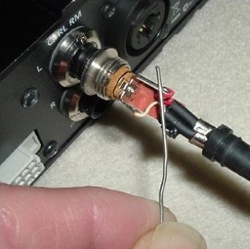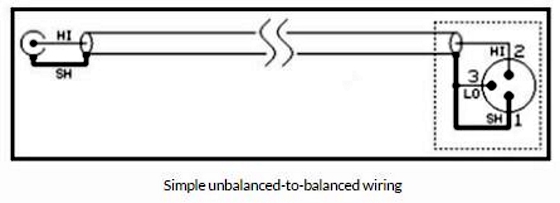
Back to the value of the differential input: When a cable connecting the devices gets too close to a noise source, noise current is induced in both wires (presumably equally since the wires are very close together). This causes the noise current to flow through the two circuit paths. Here’s where the requirement for equal output-source impedances comes into play.
Noise current going to the (+) input of the differential amplifier flows through the source impedance Zout1 while the noise current going to the (-) input of the differential amplifier flows through Zout2.
Since the currents and impedances are equal, Ohm’s Law tells us that equal noise voltages will be seen at each of the two output terminals of Device A, each one resulting from the noise current flowing through its respective Zout. To a differential amplifier, volts are volts, and the noise is indistinguishable from the desired signal.
However, since the noise has the same polarity at both inputs, when the differential amplifier at the input of Device B subtracts the two voltages, the resultant voltage is zero. Presto! The noise is canceled. This, known as common mode rejection, is the advantage of a balanced connection.
Typically, XLR or TRS (tip-ring-sleeve) ¼-inch phone connectors are used for balanced connections, but be aware that while something might look like a balanced connector, the manufacturer didn’t necessarily wire it that way. Some XLRs are wired unbalanced, sometimes with a balancing option available at extra cost, though this is usually only with older (“vintage”) equipment. TRS jacks are commonly used for headphones and channel inserts but these are actually two unbalanced circuits (left/right outputs for headphones and send/return for inserts). Don’t get fooled by looks. RTFM!
Interconnecting Balanced and Unbalanced Devices
These days, most equipment is designed so that balanced and unbalanced connections in a system can be mixed successfully, but different input and output circuits require different ways of making two wires out of three (or one wire out of two, if you don’t count the shield).
Connecting an unbalanced output to a balanced input is straightforward: Simply connect the low (inverting) side of the input to ground. This puts makes one side of the differential always zero volts. Subtracting zero from the signal on the hot input doesn’t affect it in a good or bad way.
This method of wiring between an unbalanced output and a balanced input has everything you need for a complete circuit, and you’ll get a signal to the balanced device. The problem with this method of connection, however, is that it has no common mode rejection. If a cable connecting two devices in this manner (or, for that matter, connecting two unbalanced devices) gets too close to the flashing neon BEER sign in the window of the bar directly behind the stage, you’ll probably have some buzz that you can’t eliminate easily.
If your unbalanced output and balanced input are on ¼-inch jacks, connecting them with a “guitar” (unbalanced) ¼-inch-to-¼-inch cable is the electrical equivalent of the aforementioned circuit. The tip of the plug makes contact with the tip terminal of the jack, as usual, while the ring terminal of the jack connects to the sleeve of the plug, which grounds the low side of the input. It’s convenient but still with no common mode rejection.
Here’s an alternative and better method of wiring between an unbalanced output and balanced input. By using two-conductor shielded cable, you are at least taking partial advantage of the noise-canceling characteristics of the differential amplifier at the balanced input. Such a connection can provide 20 to 30 dB of common mode rejection—not as good as the 60 dB or more that you’ll get with a balanced source but it’s better than nothing. The disadvantage is that cables wired this way are difficult if not impossible to find off the shelf. Nearly all premade XLR-TS or XLR-RCA cables, and even XLR adapters, are wired with single-conductor cable. For connections like this, you’ll nearly always have to make your own or modify a premade cable but that’s a good skill to develop.


